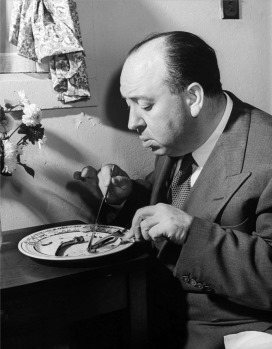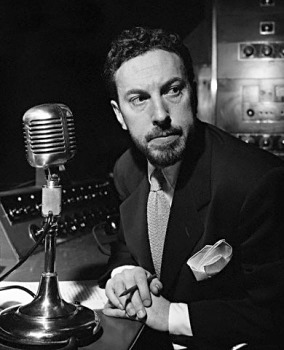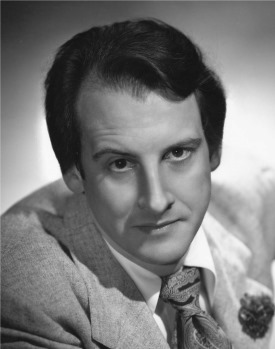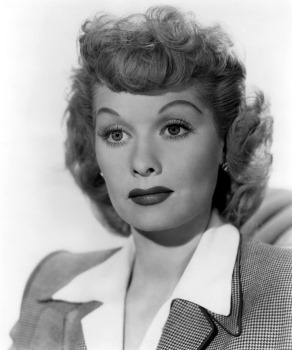It really began with Alfred Hitchcock.

In mid-1940, as “The Lux Radio Theatre” was leaving the air for its annual summer hiatus, the CBS Radio Network decided to forego the standard practice of replacing a popular show with a short-run series and, instead, decided to use the weekly hour to offer a series of “pilot” programs - that is, shows that were being considered for a regular timeslot if a sponsor decided to underwrite their production. Titling the experiment “Forecast”, the series kicked off on July 14th with a thirty minute musical broadcast pitting a symphonic orchestra featuring violinist Albert Spaudling against a swing band featuring violinist Joe Venuti, then continued into the next half-hour with a dramatic series starring Frederic March and Florence Eldridge in an adaptation of a Booth Tarkington story.
But it was the second week of the series that presented the first glimpse of a program that would eventually run for twenty years on radio and, from 1949 thru 1954, on television as well. In the second half-hour of July 22, 1940, following a thirty minute musical revue featuring Danny Kaye, “Forecast” presented a mystery show titled “Suspense”. Directed by Alfred Hitchcock, the show presented a radio version of the director’s 1926 film “The Lodger”, based on the story by Marie Belloc Lowndes and starring Herbert Marshall and Edmund Gwenn. This was the soon-to-be legendary director’s first foray into radio drama -- and he did it with the promise from CBS that his latest film, “Foreign Correspondent”, would get a sizeable plug on the network before and after the show. To secure the services of such a well-known film director, CBS agreed to this codicil-- and, with a score by Wilbur Hatch, as well as performances by radio veterans Lurene Tuttle and Joseph Kearns, “Suspense” was heard for the very first time.
Interestingly enough, the show was not really a success, partly because it was a summer replacement show but also because Hitchcock, always aware of the publicity value of controversy, chose to leave the ending of his story ambiguous and unresolved. “The Lodger” was based, in part, on the legend of Jack the Ripper, the notorious and never-identified London serial killer of the late 19th century, and to leave such a story unresolved was, in the minds of many who heard the broadcast, itself a criminal act. In the weeks to come, CBS would receive many phone calls and letters protesting the ending of the show, with a few actually claiming that such an ending was both indecent and immoral -- which was, of course, exactly what Hitchcock had hoped for.
Unfortunately, the “Forecast” version of “Suspense”, despite all the publicity, didn’t immediately lead to the pilot becoming a series. Had it done so, the “Suspense” we know today might well have become a vehicle for Hitchcock to adapt more of his films for radio -- but that’s not what happened. In fact, “Suspense” languished for two full years without another airing, while “Forecast” continued on to present more never-to-be-heard-again shows such as “Leave It to Jeeves”, based on the Wodehouse stories, “Bethel Merriday” starring Margaret Sullavan as a legendary stage actress, and musical shows with Paul Robeson, Woody Guthrie, and Burl Ives. (The only true success of “Forecast’s” first summer series was “Duffy’s Tavern”, starring Ed Gardner as the bartender of an east side New York dive that attracted a wide variety of oddballs and eccentrics - and which also attracted millions of listeners during its eight-year run.)
 Fast forward to June of 1942. Charles Vanda, who had earlier worked on “The Columbia Workshop” and had also produced some of the shows in “Forecast’s” two seasons, remembered “Suspense” and proposed that CBS present a revised version as, once again, a summer replacement series. This time, the star would not be a big-league Hollywood director but, instead, the stories themselves. CBS agreed and, on June 17, 1942, “Suspense” was reborn as a weekly anthology series, sustained by the network. Vanda stayed with the show only a few weeks and was soon replaced with William Spier, another “Forecast” veteran and occasional on-air performer who was thought to be an up-and-comer by the network. Recognizing the opportunity that “Suspense” presented, Spier proceeded to mold the show into the radio classic that we know today -- but it wasn’t easy.
Fast forward to June of 1942. Charles Vanda, who had earlier worked on “The Columbia Workshop” and had also produced some of the shows in “Forecast’s” two seasons, remembered “Suspense” and proposed that CBS present a revised version as, once again, a summer replacement series. This time, the star would not be a big-league Hollywood director but, instead, the stories themselves. CBS agreed and, on June 17, 1942, “Suspense” was reborn as a weekly anthology series, sustained by the network. Vanda stayed with the show only a few weeks and was soon replaced with William Spier, another “Forecast” veteran and occasional on-air performer who was thought to be an up-and-comer by the network. Recognizing the opportunity that “Suspense” presented, Spier proceeded to mold the show into the radio classic that we know today -- but it wasn’t easy.
A man of both taste and ambition, William Spier began his tenure with “Suspense” by gathering his cast and crew together and giving them the word that, from now on, they would all play an intrinsic part in the creation of each show. As with any sustained show, budgets were tight - but this didn’t mean that the people Spier had to work with didn’t have talents and abilities far greater than they had usually been given the chance to display. For instance, Spier called upon musical director Bernard Hermann and, later, Lucien Moraweck to not only write and conduct cues for each show, but asked that their music play a role in each drama - almost as if it were another character. Sound effects man Berne Surrey, who was used to being giving a list of the necessary effects for each show just a few hours before the broadcast, now found himself working side by side with Spier to plot out where the various sounds would be most effective and just what they should be. With his actors - young but widely experienced radio hands such as Roger De Koven, Hans Conreid, Alice Frost, Helen Lewis, Ted Osborne, Frank Readick, Martin Gabel, Ted de Corsia, and Michael Fitzmaurice - he expected nothing less than perfection, but was also willing to risk on-air disaster by often throwing them a curve at the last minute. Spier wanted a tense, edge-of-your-seat kind of show -- and the best way to get this, in his opinion, was by keeping his entire cast and crew as tense and on-edge as the audience would be.
For scripts, Spier relied primarily on John Dickson Carr, who either adapted existing stories or wrote originals for the series. Carr had, for many years, been making a comfortable living as the author of mystery and detective novels, most published in paperback form and featuring such detectives as Dr. Fell and Sir Henry Merrivale. Carr had long established himself as the master of the “locked door mystery” - complex, puzzling, and plot-driven stories in which a detective solves seemingly impossible crimes. Such baffling tales became a staple of “Suspense” - but William Spier wanted still more from his creative team. Rather than present fantastic or bizarre stories, Spier wanted them kept close to home - and here is where the basic visions of Hitchcock and Spier converged: in their individual fields of entertainment, both insisted upon stories where an average man or woman, apparently minding their own business, ends up caught in an ever more tangled web of disaster, fear, and confusion. Conclusions would be left until the very last minute, allowing listeners the chance to not only visualize the story but, in fact, see themselves in the same situation. How would they react? What would they do? And could such a thing, in fact, actually happen to them? It’s no wonder that William Spier soon earned the title of “the Hitchcock of the Airwaves” - and that “Suspense” soon became a major success for CBS.

 Quality generally attracts quality -- and so “Suspense” soon began to attract Hollywood stars to its microphones. But here as well, Spier differed from his radio colleagues. He knew that name talent would undoubtedly attract listeners, but he also knew that most movie actors and actresses had very seldom been given the chance to really flex their acting muscles on the air. Appearances on such series as “Hollywood Hotel”, “Screen Guild”, and “The Lux Radio Theatre” usually meant recreating a previous film role and chatting personably with a host or hostess. But on “Suspense”, such stars as Robert Young, Gene Kelly, Cary Grant, Eddie Bracken, and Van Johnson would truly have to prove their mettle, frequently in roles that cast them against type. This wasn’t, however, stunt casting - the notion of, say, a screen villain like Laird Cregar or Vincent Price playing a romantic lead or Lucille Ball or Virginia Bruce being menaced just for the sake of publicity. Hollywood stars were required to deliver the same intense performances as their radio-based co-stars -- and most not only delivered but were thrilled by the opportunity to do so. Enthusiastic participant Cary Grant, for example, was frequently quoted as saying that, if he ever did any additional radio work, it would be on “Suspense”, “where I get a chance to act!”
Quality generally attracts quality -- and so “Suspense” soon began to attract Hollywood stars to its microphones. But here as well, Spier differed from his radio colleagues. He knew that name talent would undoubtedly attract listeners, but he also knew that most movie actors and actresses had very seldom been given the chance to really flex their acting muscles on the air. Appearances on such series as “Hollywood Hotel”, “Screen Guild”, and “The Lux Radio Theatre” usually meant recreating a previous film role and chatting personably with a host or hostess. But on “Suspense”, such stars as Robert Young, Gene Kelly, Cary Grant, Eddie Bracken, and Van Johnson would truly have to prove their mettle, frequently in roles that cast them against type. This wasn’t, however, stunt casting - the notion of, say, a screen villain like Laird Cregar or Vincent Price playing a romantic lead or Lucille Ball or Virginia Bruce being menaced just for the sake of publicity. Hollywood stars were required to deliver the same intense performances as their radio-based co-stars -- and most not only delivered but were thrilled by the opportunity to do so. Enthusiastic participant Cary Grant, for example, was frequently quoted as saying that, if he ever did any additional radio work, it would be on “Suspense”, “where I get a chance to act!”
Heard today, “Suspense” remains a true radio classic -- and one for which there are very few equals. As with any series, the programs have their ups and downs but, for the most part, it’s impressive just how well these “well calculated tales” still stand up to critical ears. The best shows in the series - the legendary and much-repeated “Sorry, Wrong Number” featuring a bravura performance by Agnes Moorehead, for instance, or “Dime a Dance” starring Lucille Ball as a dance hall girl being stalked by a murderous customer - still retain their power to both shock and engross the listener. And, in this Radio Archives collection, you’ll have the chance to hear twenty broadcasts from the series, just as originally aired between 1943 and 1944 and featuring such diverse stars as Geraldine Fitzgerald, Lillian Gish, Orson Welles, Charles Laughton, Frederic March, and Reginald Gardiner. If you’re a long-time fan of radio entertainment - or, especially, if you’re discovering it for the first time - these great sounding and fully restored shows will both thrill and delight you just as much as they did radio audiences in the 1940s.
The Man Without a Body
starring Wendy Barrie, with John Sutton, George Zucco, and Joseph Kearns as “The Man In Black”
Tuesday, June 22, 1943 - 30:00 - CBS, sustaining
Murder Goes for a Swim
starring Warren William as “The Lone Wolf”, with Eric Blore and Ted Osborne as “The Man In Black”
Tuesday, July 20, 1943 - 30:00 - CBS, sustaining
The Last Letter of Dr. Bronson
starring Laird Cregar and George Coulouris, with Harold Huber, Helen Vinson, Ian Wolfe, Walter Kingsford, Theodore Von Eltz, and Ted Osborne as “The Man In Black”
Tuesday, July 27, 1943 - 30:00 - CBS, sustaining
A Friend to Alexander
starring Robert Young and Geraldine Fitzgerald, with Ted Osborne as “The Man In Black”
Tuesday, August 3, 1943 - 30:00 - CBS, sustaining
The King’s Birthday
starring Dolores Costello, with George Zucco, Ian Wolfe, Martin Koslick, Louis Pelletier, and Berry Kroeger as “The Man In Black”
Saturday, August 28, 1943 - 30:00 - CBS, sustaining
Marry for Murder
starring Lillian Gish, with Ray Collins, Bramwell Fletcher, Otto Kruger, and Berry Kroeger as “The Man In Black”
Thursday, September 9, 1943 - 30:00 - CBS, sustaining
The Most Dangerous Game
starring Orson Welles and Keenan Wynn, with Joseph Kearns as “The Man In Black”
Thursday, September 23, 1943 - 30:00 - CBS, sustaining
Statement of Employee Henry Wilson
starring Gene Lockhart, with Hans Conried, William Johnstone, John McIntire, and Joseph Kearns as “The Man In Black”
Tuesday, November 2, 1943 - 30:00 - CBS, sustaining
Thieves Fall Out
starring Gene Kelly, with Hans Conried, Harry Lang, and Joseph Kearns as “The Man In Black”
Tuesday, November 16, 1943 - 30:00 - CBS, sustaining
The Strange Death of Charles Umberstein
starring Vincent Price, with Hans Conried and Joseph Kearns as “The Man In Black”
Tuesday, November 23, 1943 - 30:00 - CBS, sustaining
Dime a Dance
starring Lucille Ball, with Hans Conried, Pat McGeehan, Jeanette Nolan, Ian Wolfe, and Joseph Kearns as “The Man In Black”
Thursday, January 13, 1944 - 30:00 - CBS, sponsored by Roma Wines
A World of Darkness
starring Paul Lukas, with Hans Conried, Ian Wolfe, and Joseph Kearns as “The Man In Black”
Thursday, January 20, 1944 - 30:00 - CBS, sponsored by Roma Wines
Sorry, Wrong Number
starring Agnes Moorehead, with Cathy Lewis, Hans Conried, Harry Lang, John McIntire, and Joseph Kearns as “The Man In Black”
Thursday, February 24, 1944 - 30:00 - CBS, sponsored by Roma Wines
Portrait Without a Face
starring George Coulouris, with Hans Conried, Michele Morgan, Phillip Dorn, and Joseph Kearns as “The Man In Black”
Thursday, March 2, 1944 - 30:00 - CBS, sponsored by Roma Wines
The Visitor
starring Eddie Bracken, with Hans Conried, John McIntire, Jeanette Nolan, Ken Christy, and Joseph Kearns as “The Man In Black”
Thursday, May 11, 1944 - 30:00 - CBS, sponsored by Roma Wines
The Man Who Knew How
starring Charles Laughton, with Hans Conried, Ian Wolfe, and Joseph Kearns as “The Man In Black”
Thursday, August 10, 1944 - 30:00 - CBS, sponsored by Roma Wines
Actor’s Blood
starring Fredric March, with Hans Conried, Harry Lang, John McIntire, and Joseph Kearns as “The Man In Black”
Thursday, August 24, 1944 - 30:00 - CBS, sponsored by Roma Wines
The Merry Widower
starring Reginald Gardiner, with Joseph Kearns as “The Man In Black”
Thursday, October 12, 1944 - 30:00 - CBS, sponsored by Roma Wines
The Night Man
starring Virginia Bruce, with Joseph Kearns as “The Man In Black”
Thursday, October 26, 1944 - 30:00 - CBS, sponsored by Roma Wines
The Singing Walls
starring Van Johnson, with Wally Maher, Ken Christy, and Joseph Kearns as “The Man In Black”
Thursday, November 2, 1944 - 30:00 - CBS, sponsored by Roma Wines